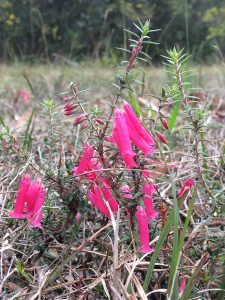
Epacris impressa (or common heath) by Kate Burke
Over the weekend, in the name of taking the slow road (and the wide view, in the style of John Blay), I walked from Pambula Beach to Pambula along the bike track.
This track runs alongside a strip of Ben Boyd National Park on the NSW Far South Coast, and the wildflowers are having a merry late-winter time of it.
There’s loads of wattle blooming as well as other native shrubs with sprays of pink, purple and red. I’m a bit rusty on local coastal species, so this walk felt like a step into new, pretty territory.
About halfway to Pambula, the roadside forest has been cleared and mown underneath power lines.
When I see these incursions into bush I tend to shut off a bit, seeing the slashing as something to tolerate rather than to investigate. However, after a quick second glance, I saw something remarkable. It wasn’t grass that had been mown, but native shrubs, and they were blooming beautifully – in miniature.

Lady-finger Orchid by Kate Burke
Not only that but the most remarkable white flowers were popping up everywhere. Always single, with one long leaf growing elegantly up towards the big blue sky, like Lady-finger Orchids.
Aside from these single beauties, there was an array of what should have been much taller species growing happily, blooming in a rather cute stunted form under the power lines.
Have the local council inadvertently created a bonsai Ben Boyd National Park?
Without having to compete with trees for sunlight, these mini-versions seem quite happy and healthy.
And there are kangaroo droppings everywhere, indicating that the area doubles as a grazing ground for local native animals.
Still, this isn’t the normal way of things.

Pimelea linifolia, known as queen-of-the-bush or riceflower by Kate Burke
Local birds and insects rely on these plants for food and habitat, and although the mowing makes access easy for them, there’s nowhere to hide or build a nest.The plants are flourishing out of necessity – they’re resilient because they have to be. This is a lovely surprise, but I wouldn’t call it a supportive argument for clearing forest and slashing shrubbery.
And it won’t be attracting tourists in a hurry, I’m on my knees taking photos, getting odd looks from the drivers whizzing past. They can’t see what I’m looking at. To them, it’s just another mown patch of scrubby grass.
I’m glad I stopped for a moment to appreciate the little things – they’re beautiful.
Pic 1: Usually 1 to 1.5m tall, this Epacris impressa (or common heath) plant is around than 15cm high. By Kate Burke
Pic 2: Lady-finger Orchids by Kate Burek
Pic 3: Pimelea linifolia, known as queen-of-the-bush or rice flower. The bark of this shrub is also known as “bushman’s bootlace”, and has traditional indigenous use as a material for twine to make nets to catch Bogong Moths in alpine regions. This specimen is around 20cm tall. By Kate Burke







